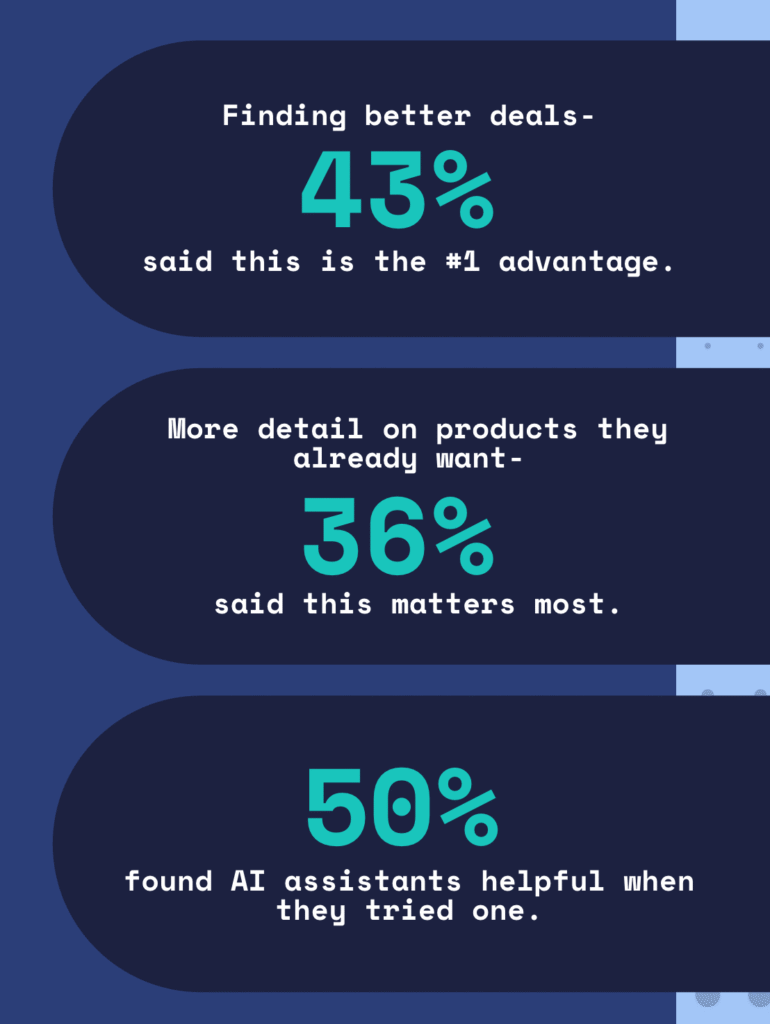
New survey: 67% of shoppers want AI to explain products, not buy them
The conventional wisdom about AI shopping assistants has it backwards. While tech leaders envision autonomous agents making purchases on behalf of consumers, new research reveals customers have a fundamentally different relationship with AI in their buying journey.
According to fresh survey data from Lucidworks involving 400 average online consumers, the real opportunity for AI in retail isn’t about replacing human decision-making… it’s about supercharging it with better information, exactly when and where customers need it most.
Prioritize information over automation with AI
The numbers tell a compelling story about what consumers actually want from AI:
- 43% cite finding better deals as the #1 advantage of AI shopping assistance
- 36% want more detailed product information for items they’re already considering
- Only 29% are comfortable with AI making purchases under $100 on their behalf
- Just 35% show any willingness to let AI make autonomous purchasing decisions
This represents a fundamental shift in how retailers should be thinking about AI implementation.
Put AI at the point of decision
The survey data reveals that consumers are most receptive to AI assistance during the consideration and evaluation phases of their buying journey, but not during discovery or purchase completion. This creates an enormous opportunity for retailers who deploy AI experiences on their product detail pages (PDPs).

For retailers, this means the highest-impact AI deployment isn’t about traffic acquisition or checkout automation, but actually about conversion optimization through better information delivery.
The PDP revolution: Where conversion happens
Product detail pages represent the critical moment in the customer journey where interest transforms into intent. Yet most PDPs remain static information repositories rather than dynamic, responsive experiences.
Here’s what customers actually ask at this crucial moment:
- “How does this compare to [alternative]?”
- “Is this compatible with what I already have?”
- “What are the real-world pros and cons?”
- “How do I know this will work for my specific situation?”
Traditional PDPs answer none of these questions dynamically. AI-powered experiences can answer all of them, instantly.
The technical specifications challenge
For retailers with complex catalogs — from industrial equipment to consumer electronics — technical documentation represents both a huge asset and a massive accessibility problem.
AI agents that can parse technical documentation, spec sheets, and compatibility matrices in real-time solve this problem directly. Instead of forcing customers to download PDFs or hunt through documentation, they can ask: “Will this work with my existing setup?” and get immediate, accurate answers.
Real results: Early adopters see dramatic lifts
While comprehensive case study data is still emerging, early indicators from retailers implementing PDP-focused AI experiences show significant impact:
- Conversion rate improvements ranging from 15-40% on pages with AI assistance
- Reduced cart abandonment as customers get answers before reaching checkout
- Higher average order values as AI helps customers find the right products initially
- Decreased return rates due to better product fit and expectation setting
The implementation reality: Start where it matters most
The survey data suggests a clear implementation strategy for retailers:
Phase 1: High-consideration products
Deploy AI experiences on your most complex, highest-value product pages first. These see the biggest impact and face the least consumer resistance.
Phase 2: Comparison-heavy categories
Focus on product categories where customers frequently compare multiple options or need detailed specification analysis.
Phase 3: Scale across catalog
Expand to broader product ranges as AI systems learn and improve from initial deployments.
The zero-click internet may be coming, but the immediate opportunity lies in making your existing customer journey more intelligent, more responsive, and more conversion-focused. The data shows customers are ready for this evolution — the question is whether retailers will meet them where they are.
For detailed implementation strategies and comprehensive survey findings, download the full report: “Zero-Click Internet 2035: A Playbook for Digital Leaders.”